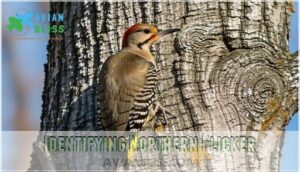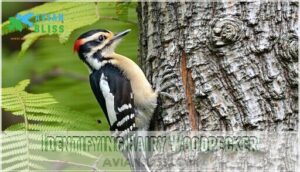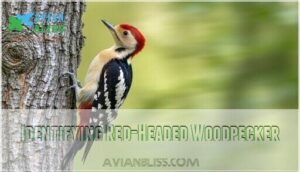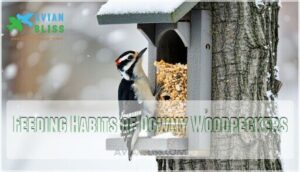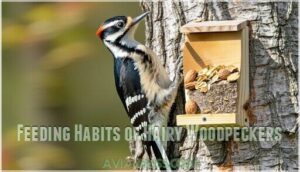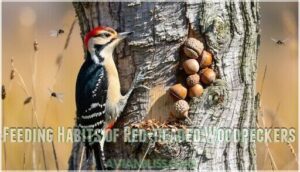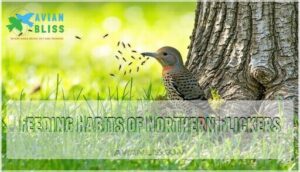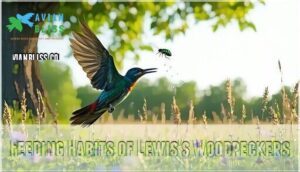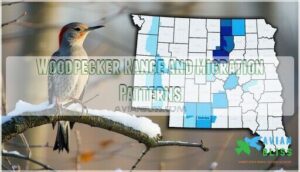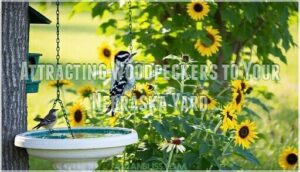This site is supported by our readers. We may earn a commission, at no cost to you, if you purchase through links.
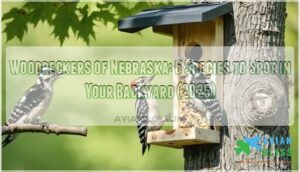
The pocket-sized Downy Woodpecker visits backyard feeders like clockwork, while its larger cousin, the Hairy Woodpecker, prefers mature forests.
Red-bellied Woodpeckers aren’t actually red on their bellies—they sport zebra-striped backs and peachy underparts.
The stunning Red-headed Woodpecker looks like it’s wearing a crimson helmet, and Northern Flickers spend more time on the ground hunting ants than most woodpeckers.
Lewis’s Woodpeckers show up during migration with their distinctive salmon-pink bellies.
Each species has unique feeding habits, preferred habitats, and identification tricks that’ll help you become a backyard birding expert.
Table Of Contents
- Key Takeaways
- Woodpeckers Found in Nebraska
- Woodpecker Identification in Nebraska
- Woodpecker Behavior and Diet
- Woodpecker Range and Migration Patterns
- Attracting Woodpeckers to Your Nebraska Yard
- Frequently Asked Questions (FAQs)
- Are there woodpeckers in Nebraska?
- Are downy woodpeckers common in Nebraska?
- Are there red-bellied woodpeckers in Nebraska?
- Are there woodpeckers in Tennessee?
- Which birds are found in Nebraska?
- Are there woodpeckers in Arkansas?
- What bird looks like a woodpecker but isn’t?
- How can you tell a sapsucker from a woodpecker?
- What is the largest woodpecker in Nebraska?
- What does it mean when woodpeckers pecking at your house?
- Conclusion
Key Takeaways
- You’ll find six woodpecker species in Nebraska year-round, including the tiny Downy Woodpecker, larger Hairy Woodpecker, Red-bellied with zebra-striped backs, Red-headed with crimson helmets, ground-hunting Northern Flickers, and migrating Lewis’s Woodpeckers with salmon-pink bellies.
- You can identify each species by size, bill length, and color patterns—Downy Woodpeckers have short bills half their head length, while Hairy Woodpeckers have bills equal to their head length, and Red-bellied Woodpeckers don’t actually have red bellies despite their name.
- You’ll attract these birds to your yard with high-fat suet feeders, shallow bird baths, and native trees like oak and hickory that provide natural food sources and nesting sites throughout Nebraska’s changing seasons.
- You’ll notice each species has unique feeding habits—Northern Flickers hunt ants on the ground unlike other tree-drilling woodpeckers, Red-headed Woodpeckers store acorns in tree crevices, and Lewis’s Woodpeckers catch insects mid-flight like flycatchers.
Woodpeckers Found in Nebraska
You’ll find six distinct woodpecker species calling Nebraska home, from the tiny Downy Woodpecker to the impressive Northern Flicker.
These remarkable birds range in size from 5 inches to over 12 inches long, and each species brings its own unique feeding habits, colorful markings, and drumming patterns to Nebraska’s diverse landscapes, showcasing their unique characteristics.
Downy Woodpecker
The Downy Woodpecker is Nebraska’s smallest woodpecker species, measuring just 5.5-6.7 inches.
Nebraska’s tiniest drummer, the Downy Woodpecker packs big personality into its 6-inch frame.
You’ll spot its distinctive checkered pattern on black and white wings. Males display red markings on their head’s back.
These year-round residents maintain an insect diet, feeding on beetles and larvae.
Here’s what makes Downy identification easy:
- Downy size – Smallest among Nebraska woodpeckers
- Bill length – Short, half the head’s length
- Feeding behavior – Acrobatic foraging on thin branches
Hairy Woodpecker
You’ll spot Hairy Woodpeckers across Nebraska’s mature forests year-round, where these Nebraska woodpeckers prefer large trees for nesting.
Hairy Size ranges 7-10 inches with longer bills than their Downy cousins.
Their Hairy Diet includes beetles and larvae found in bark crevices.
Listen for their sharp "peek" call – Hairy Sounds that echo through woodlands.
Hairy Habitat features old-growth trees where they excavate nest holes.
Attract them with suet feeders in your backyard.
Red-bellied Woodpecker
You’ll recognize the red-bellied woodpecker by its misleading name—despite being called "red-bellied," its belly coloration shows pale grayish-white with subtle reddish tinges.
This redbellied woodpecker thrives in Nebraska’s mature forests and wooded areas, making it one of the most recognizable common woodpeckers.
Their habitat preference includes oak and hickory trees.
Listen for their distinctive vocalizations—a rolling "churr" call.
Their nesting habits involve excavating cavities in dead wood, while regional variations show slight size differences across Nebraska birds populations.
- Rolling "churr" calls echo through forests
- Excavates nest cavities in dead trees
- Prefers oak and hickory woodlands
Red-headed Woodpecker
Distinctive from other Nebraska woodpecker species, the Red-headed Woodpecker displays bold plumage variations with its crimson head contrasting against black and white stripes.
These common woodpeckers practice unique food storage behaviors, caching acorns in tree crevices.
Unfortunately, habitat loss has affected their conservation status.
Their distinctive vocalizations help with woodpecker identification throughout Nebraska’s open woodlands and wetlands.
Northern Flicker
Looking for Nebraska’s most widespread Northern Flicker? You’ll spot this ground-loving woodpecker year-round across the state. Unlike tree-climbing relatives, flickers prefer hunting ants on lawns and open areas. Their brown plumage with black bars and distinctive white rump patch make woodpecker identification easy.
Here’s what makes flickers special:
- Flicker subspecies include yellow-shafted and red-shafted varieties
- Flicker vocalizations feature loud "wicka-wicka" calls
- Flicker nesting occurs in dead trees or telephone poles
- Flicker drumming serves territorial communication purposes
Flicker conservation efforts focus on maintaining suitable woodpecker habitat throughout Nebraska’s diverse landscapes.
Lewis’s Woodpecker
Unlike other Nebraska woodpeckers, Lewis’s Woodpecker sports dark greenish-black plumage with a striking pink-red belly.
You’ll spot this medium-sized bird in open Ponderosa Pine forests, where it catches insects mid-flight rather than drilling into bark.
Its slow, gliding flight pattern makes Lewis’s appearance unmistakable during woodpecker identification.
The site also offers options for species group downloads if you’re interested in a broader overview.
| Feature | Lewis’s Woodpecker | Other Nebraska Species |
|---|---|---|
| Flight Pattern | Slow, gliding | Quick, undulating |
| Feeding Method | Catches insects mid-air | Drills into bark |
| Habitat | Open pine forests | Various forest types |
Woodpecker Identification in Nebraska
You’ll need to look at specific features like size, color patterns, and beak length to tell Nebraska’s woodpeckers apart from each other.
Start by checking the bird’s overall size first, then examine the head markings and back patterns, since these details will help you narrow down which of the six common species you’re watching at your feeder, using features like size.
Identifying Northern Flicker
Northern Flicker identification starts with recognizing their distinctive brown backs marked by bold black bars.
You’ll spot Flicker markings including a prominent white rump patch during flight. Listen for unique Flicker calls – their loud "wicka-wicka-wicka" echoes through Flicker habitat of open woodlands.
Attracting birds to your yard can help spot them. Flicker subspecies show yellow or red wing linings, making identifying woodpeckers easier in Nebraska’s diverse woodpecker types.
Identifying Red-Bellied Woodpecker
The Red-bellied Woodpecker throws many birdwatchers a curveball—don’t expect a bright red belly! Instead, you’ll spot zebra-like black and white stripes across their backs and wings.
The Red Head Markings vary by gender: males sport a complete red cap from forehead to nape, while females show red only on the nape. Their Belly Coloration appears grayish-white with subtle reddish tinges.
Habitat Clues include oak woodlands and suburban areas with mature trees throughout Nebraska. Call Identification helps too—listen for their distinctive "churr" sound.
When identifying woodpeckers in Nebraska, remember these Redbellied Woodpeckers often visit suet feeders.
Key identification features:
- Black and white striped back pattern
- Males have full red caps, females red napes only
- Grayish belly with light red wash
- Loud churring calls year-round
Identifying Hairy Woodpecker
The Hairy Woodpecker looks like the Downy’s bigger sibling but has key differences for Nebraska bird identification.
The key differences can be summarized in the following table:
| Feature | Hairy Woodpecker | Downy Woodpecker | Identification Tip |
|---|---|---|---|
| Size Comparison | 7.1-10.2 inches | 5.5-6.7 inches | Hairy is noticeably larger |
| Bill Length | Equals head length | Half head length | Hairy’s bill looks proportionally longer |
| Plumage Details | Pure white outer tail feathers | Black-spotted white outer tail feathers | Check tail feather markings |
| Drumming Patterns | Longer, more intense rolls | Shorter, softer taps | Listen for drumming intensity |
| Habitat Clues | Mature forests, larger trees | Parks, backyards, smaller trees | Hairy prefers bigger woodlands |
Their sharper calls echo through Nebraska’s older forests.
Identifying Red-Headed Woodpecker
You’ll easily identify the Redheaded Woodpecker by its striking adult plumage—a brilliant crimson head contrasts with pure white underparts and black wings.
These Nebraska woodpeckers stand out from similar species through three key features:
- Solid red head covering entire head and neck
- Bold white wing patches visible during flight
- Harsh kweer vocalizations echoing through open habitat clues
Identifying Lewis’s Woodpecker
You’ll recognize Lewis’s Woodpecker by its stunning plumage variations that set it apart from other Nebraska woodpecker sightings.
Look for these distinctive features:
- a pink belly,
- a gray collar,
- an oily-green back, and
- a red face.
Their flight patterns differ dramatically from typical woodpeckers—they glide gracefully instead of undulating.
Size comparison shows they’re medium-sized birds, and it’s essential to check range maps, as they’re uncommon in Nebraska’s western regions, making range maps a crucial tool for spotting them.
Woodpecker Behavior and Diet
You’ll find that Nebraska’s woodpeckers have fascinating eating habits that change with the seasons, from the Downy Woodpecker’s love of beetle larvae to the Northern Flicker’s unusual preference for ground-dwelling ants.
Each species uses specialized techniques like the Red-headed Woodpecker’s food-storing behavior and the Yellow-bellied Sapsucker‘s tree-tapping skills to survive Nebraska’s changing weather conditions.
Feeding Habits of Downy Woodpeckers
You’ll spot Downy Woodpeckers using specialized beak adaptations for precise insect consumption.
Their foraging techniques include extracting insect larvae from bark crevices and drilling small holes.
Seasonal diet shifts from summer insects to winter suet and seeds.
Their feeding behavior shows remarkable flexibility—they’ll hang upside-down on branches and store acorns in tree bark for later meals.
Feeding Habits of Hairy Woodpeckers
Beetle-hunting specialists, Hairy Woodpeckers demonstrate precise foraging techniques when searching for wood-boring insect larvae beneath bark crevices.
Their seasonal diet shifts based on habitat influence and prey availability.
Here’s what drives their feeding behavior:
- Insect consumption peaks during spring breeding season
- Larvae preference focuses on beetle grubs and carpenter ants
- Winter suet supplements provide essential fat reserves
- Woodpecker diet includes occasional nuts and berries
Attract them with a cedar suet feeder designed for clinging.
Feeding Habits of Red-bellied Woodpeckers
Red-bellied Woodpeckers showcase impressive diet adaptations throughout Nebraska’s changing seasons.
Their woodpecker diet varies substantially, demonstrating sophisticated foraging techniques that impact the ecosystem positively.
Seasonal Diet highlights include:
- Insects like beetles and ants during spring breeding
- Seeds and acorns collected through summer months
- Nuts stored using food storage behaviors for winter
- Fruits and berries when available seasonally
- Suet from backyard feeders year-round
Feeding Habits of Red-headed Woodpeckers
You’ll find Red-headed Woodpeckers showcase remarkable Diet Adaptations throughout Nebraska’s changing seasons.
Their diverse woodpecker diet includes insects, flying bugs they catch mid-air, and various seeds.
These birds excel at Food Storage, tucking away acorns and nuts in tree crevices for winter meals.
Their Seasonal Diet shifts from heavy Insect Consumption during summer to stored nuts when temperatures drop.
Unlike the Rednaped Sapsucker, their Foraging Behavior combines aerial hunting with ground searches, making them nature’s versatile snack collectors.
Feeding Habits of Northern Flickers
Northern Flickers break the typical woodpecker mold with their unique ground foraging behavior.
You’ll spot them hopping on lawns, using their specialized tongue adaptation to extract ants from underground colonies.
Their seasonal diet varies throughout Nebraska’s changing weather:
- Ant consumption: Primary protein source year-round
- Seeds and berries: Fall and winter supplements
- Flicker food storage: Cached nuts in tree crevices
Feeding Habits of Lewis’s Woodpeckers
Unlike other woodpeckers, Lewis’s Woodpeckers catch insects mid-flight like flycatchers.
Their Unusual Diet includes aerial Insect Consumption and nuts stored in tree crevices.
Foraging Strategies adapt with Seasonal Variation – summer brings flying beetles, while winter relies on cached acorns.
| Food Type | Season | Foraging Method |
|---|---|---|
| Flying insects | Summer | Aerial hawking |
| Beetles | Spring/Summer | Mid-air capture |
| Acorns | Fall/Winter | Ground/tree collection |
| Seeds | Year-round | Surface gleaning |
| Nuts | Fall | Food Storage behavior |
Woodpecker Range and Migration Patterns
You’ll find that most woodpeckers in Nebraska stick around all year, making them reliable backyard visitors regardless of the season.
While some species like the Northern Flicker show partial migration patterns, the majority of Nebraska’s woodpeckers are year-round residents that won’t leave you guessing whether they’ll return after winter.
Range and Migration of Northern Flickers
When winter approaches, Nebraska Flickers face challenging migration decisions.
These adaptable woodpeckers show complex movement patterns across the state’s diverse landscapes.
- Migration Triggers: Temperature drops and food scarcity prompt southern movement
- Winter Range: Many Nebraska Flickers migrate to warmer southern states
- Flicker Subspecies: Different subspecies follow distinct migration routes through Nebraska
- Habitat Loss: Development impacts traditional migration corridors and woodpecker range
Range and Migration of Red-Bellied Woodpeckers
Red-bellied woodpeckers are year-round residents in Eastern Nebraska, showing minimal migration patterns unlike many other species.
Their breeding range has expanded northward due to climate influence and habitat expansion. You’ll find them consistently in the same areas throughout seasonal variations, making them reliable backyard visitors.
eBird data confirms their stable presence across Nebraska’s eastern regions. This woodpecker range stability makes identification easier since they don’t disappear seasonally like migrating species.
Understanding bird migration basics helps contrast their behavior with other species.
Range and Migration of Hairy Woodpeckers
Hairy Woodpeckers are nonmigratory residents throughout Nebraska, making them reliable backyard visitors year-round.
Their woodpecker range covers the entire state, with Population Density highest in mature forests. Climate Influence affects their Breeding Range slightly, as northern birds may shift south during harsh winters.
Habitat Variation determines where you’ll spot them most.
- Your patience pays off – these faithful residents reward dedicated observers
- Winter brings them closer – harsh weather drives them to backyard feeders
- Every sighting matters – each Hairy Woodpecker represents a thriving local ecosystem
Range and Migration of Red-Headed Woodpeckers
Red-headed Woodpeckers show complex migration patterns across Nebraska.
Unlike other species, they’re partial migrants – some stay year-round while others head south when acorns become scarce.
Habitat Loss threatens their breeding range, while Climate Impact affects Migration Triggers like food availability.
| Season | Nebraska Range | Migration Status |
|---|---|---|
| Spring | Statewide arrival | Active breeding |
| Summer | Eastern counties | Territory defense |
| Winter | Southern migration | Winter Roosting |
Range and Migration of Lewis’s Woodpeckers
Lewis’s Woodpeckers showcase unpredictable migration patterns across their western breeding range, rarely reaching Nebraska’s open habitats.
These migratory birds face significant habitat loss and climate impact, causing concerning population trends.
Conservation efforts focus on protecting Ponderosa pine forests essential for their survival.
Range maps show declining presence, making sightings increasingly rare for Nebraska birdwatchers.
Attracting Woodpeckers to Your Nebraska Yard
You can turn your Nebraska yard into a woodpecker haven by providing the right food sources, water, and nesting opportunities.
With proper feeders, native trees, and a few simple changes to your landscape, you’ll attract these fascinating birds year-round and enjoy watching their unique behaviors up close, creating a haven.
Setting Up a Woodpecker Feeder
Setting up woodpecker feeders in Nebraska requires strategic feeder placement for maximum results. Position suet feeders on mature trees, away from windows to guarantee woodpecker safety.
Many people buy a woodpecker suet feeder online.
- Choose sturdy mounting hardware that withstands Nebraska weather
- Install squirrel proofing mechanisms to protect suet recipes
- Schedule weekly feeder maintenance to prevent bacterial growth
Proper setup transforms any backyard into a woodpecker haven that’ll attract these fascinating birds consistently.
Choosing The Right Woodpecker Feeder
You’ll want suet feeders with tail props since Nebraska woodpeckers prefer clinging while eating.
Hopper feeders work well for mixed seeds, but suet remains the gold standard. Consider homemade feeders by drilling holes in logs.
Feeder placement matters—hang them six feet high with squirrel baffles to keep critters away.
These bird feeders will attract your feathered friends reliably. Many options are available for easy to clean feeders.
Providing The Right Food for Woodpeckers
Feeding Nebraska woodpeckers correctly turns your yard into a bird paradise.
These feathered friends have specific suet preferences that’ll keep them coming back for more.
- High-fat suet cakes – Downy and Hairy Woodpeckers can’t resist these energy-packed treats in your bird feeders
- Mixed seed options – Black oil sunflower seeds provide essential nutrition year-round
- Seasonal fruit offerings – Fresh berries complement their natural insect availability needs
For ideal woodpecker feeding, consider using chewy suet cake varieties.
Providing a Bird Bath for Woodpeckers
Creating the perfect bird bath transforms your Nebraska backyard into a woodpecker haven.
Position your bath in partial shade with proper bath placement near trees. Maintain water depth between one to two inches for comfortable drinking.
Choose durable bath material like ceramic or stone. Weekly cleaning frequency prevents harmful bacteria buildup.
Even winter baths attract woodpeckers when unfrozen. You’ll soon discover these backyard birds prefer fresh, shallow water over deep pools.
Partial Shade
Planting Native Trees for Woodpeckers
While bird baths provide water, native plants create year-round woodpecker havens in your Nebraska backyard.
These trees offer natural food sources and nesting sites that attract Downy Woodpeckers and Hairy Woodpeckers consistently. You might even spot a Hairy Woodpecker, which has a larger beak size.
Oak Tree Benefits include hosting insects while Native Fruit Trees provide seasonal nutrition:
- Bur oak supports extensive insect populations
- Hickory Nut Production attracts multiple woodpecker species
- Paper birch offers Birch Bark Insects for foraging
- Eastern white pine provides Pine Seed Abundance
- Red mulberry delivers summer fruit resources
Frequently Asked Questions (FAQs)
Are there woodpeckers in Nebraska?
Seven distinct woodpecker species call Nebraska home year-round. You’ll spot Downy, Hairy, Red-bellied, Northern Flicker, Yellow-bellied Sapsucker, Red-headed, and massive Pileated Woodpeckers throughout the state’s diverse forests and woodlands.
Are downy woodpeckers common in Nebraska?
Yes, you’ll find downy woodpeckers throughout Nebraska year-round.
They’re the smallest woodpeckers in North America, measuring just 5-6 inches long.
You can easily spot these common residents at backyard feeders and in wooded areas.
Are there red-bellied woodpeckers in Nebraska?
Like crimson crowns dotting Nebraska’s eastern landscape, red-bellied woodpeckers absolutely call this state home.
You’ll spot these year-round residents primarily in eastern and southeastern regions, where they thrive among mature trees and wooded areas.
Are there woodpeckers in Tennessee?
You’ll find several woodpecker species thriving throughout Tennessee’s forests and woodlands. Common residents include downy, hairy, red-bellied, and pileated woodpeckers, plus northern flickers and red-headed woodpeckers in suitable habitats year-round.
Which birds are found in Nebraska?
You’ll spot woodpeckers, cardinals, and robins across Nebraska’s landscapes.
From tiny downy woodpeckers to massive pileated species, the state hosts diverse avian residents.
Blue jays, hawks, and countless songbirds also call Nebraska home year-round.
Are there woodpeckers in Arkansas?
Arkansas hosts numerous woodpecker species year-round.
You’ll encounter Downy, Hairy, Red-bellied, and Pileated Woodpeckers in forests and backyards.
Northern Flickers and Red-headed Woodpeckers also call Arkansas home, making it a woodpecker-rich state.
What bird looks like a woodpecker but isn’t?
A backyard observer once mistook a White-breasted Nuthatch for a tiny woodpecker. You’ll often confuse nuthatches with woodpeckers—they’re both tree-climbers with similar coloring, but nuthatches walk headfirst down trunks.
How can you tell a sapsucker from a woodpecker?
You’ll notice sapsuckers have distinctive rows of small holes they drill in tree bark to collect sap.
While other woodpeckers create larger, irregular holes when hunting for insects underneath the bark, this behavior is distinct from the sapsuckers‘ method.
What is the largest woodpecker in Nebraska?
Like a medieval knight towering over squires, you’ll spot the Pileated Woodpecker as Nebraska’s largest species.
This crow-sized giant measures 16-20 inches long with distinctive red crests and white wing patches flashing through mature forests.
What does it mean when woodpeckers pecking at your house?
Woodpeckers peck your house for three main reasons: they’re hunting insects hiding in wood siding,
establishing territory through drumming sounds,
or creating nesting cavities in softer materials like cedar or pine.
Conclusion
Despite thinking you need expensive equipment to start birdwatching, spotting woodpeckers of Nebraska requires only patience and basic observation skills.
You’ve now learned to identify six unique species, from the tiny Downy Woodpecker at your suet feeder to the ground-foraging Northern Flicker in your yard.
Set up appropriate feeders, plant native trees, and provide fresh water to attract these fascinating birds.
Your Nebraska backyard can become a woodpecker haven with these simple steps and newfound identification knowledge.

